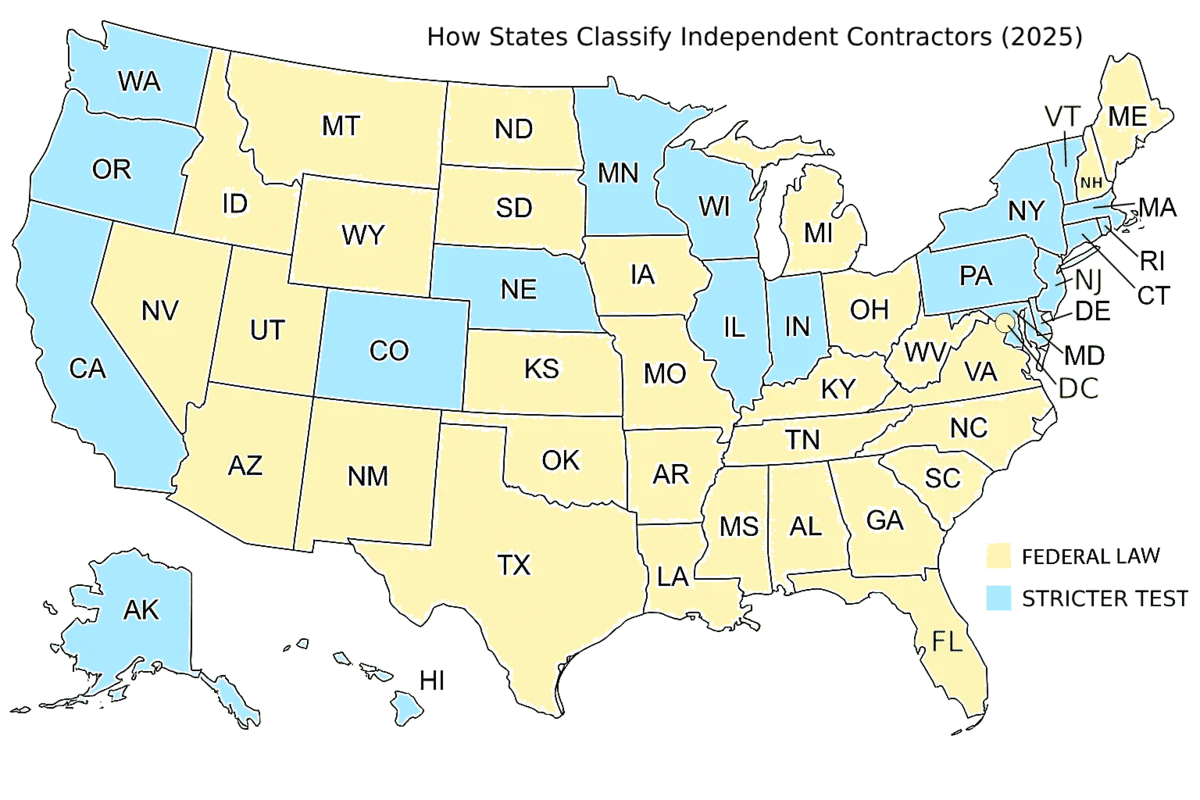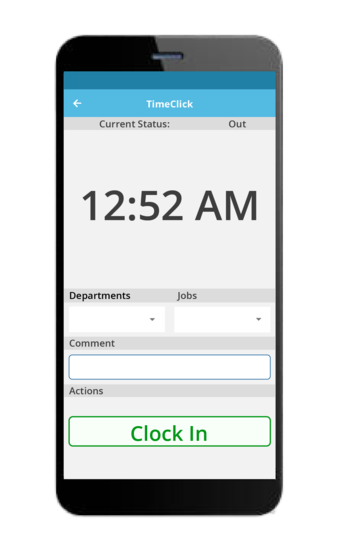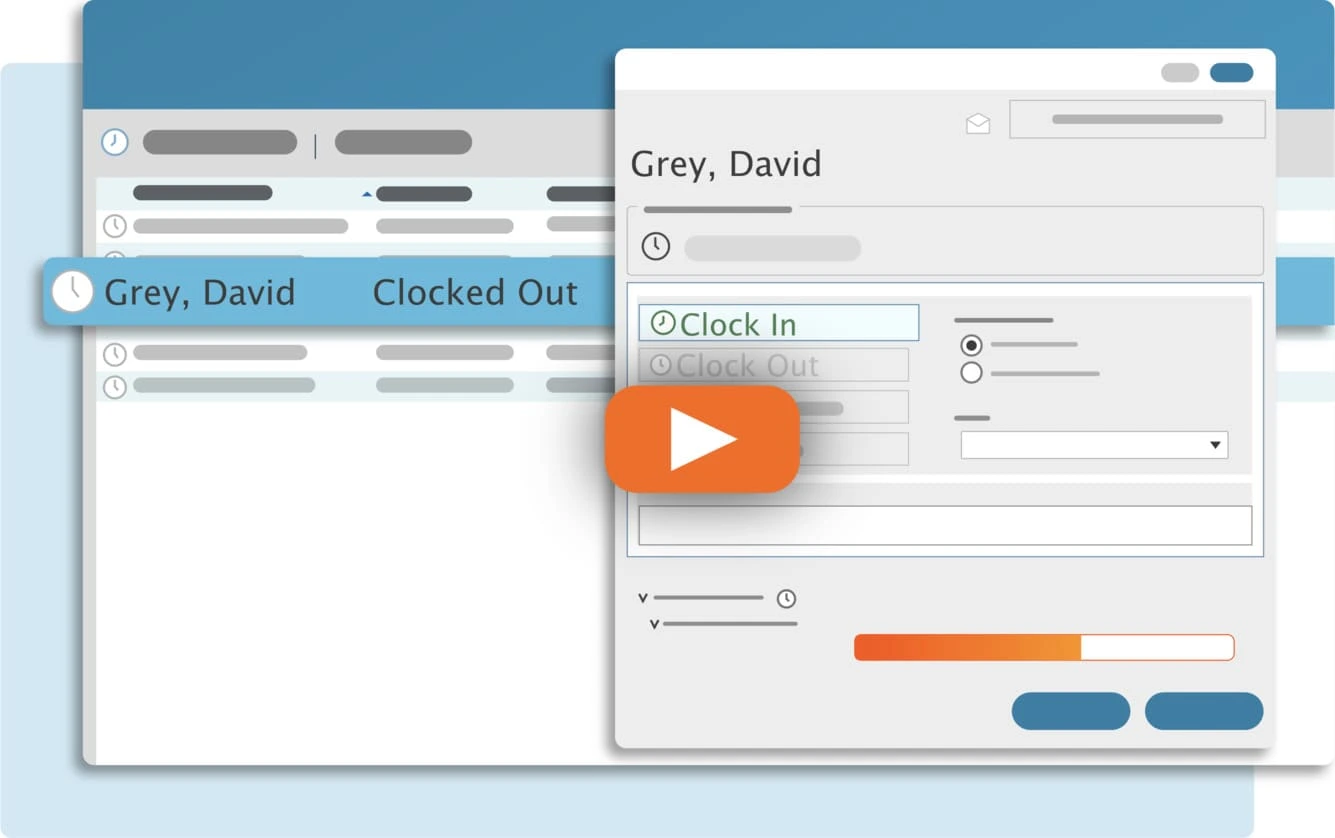Figuring out how to classify your employees isn’t just red tape — it’s one of the most important compliance decisions you’ll make. Get it wrong, and you could be facing wage disputes, IRS audits, or costly lawsuits. For small and mid-sized businesses, misclassification is one of the most common (and expensive) legal mistakes out there.
Whether you're bringing on your first hire or managing a full team, it’s critical to know the difference between an independent contractor, an exempt employee, and a non-exempt employee. These labels affect how you pay your people, when you owe overtime, and what taxes and benefits apply.
In this updated 2025 guide, we’ll walk you through the rules step by step — including the latest federal and state laws — so you can stay compliant, avoid penalties, and protect your business from surprises.
Table of Contents
- Employee vs. Independent Contractor
- Federal Standard: The Economic Realities Test
- IRS & Some State Rules: The Common-Law Test
- Stricter States: The ABC Test
- Comparison Summary
- Practical Distinctions
- Exempt vs. Non-Exempt Employees
- State-Level Considerations
- Independent Contractor Tests
- Exempt Employee Salary Thresholds
- Bottom Line
- Compliance Tips for Employers
- Mistakes to Avoid
- Frequently Asked Questions
- Conclusion
Employee vs. Independent Contractor
One of the most common — and expensive — mistakes employers make is misclassifying workers as independent contractors when they should be employees. On the surface, hiring a contractor can seem easier and more affordable, but if you’re treating them like an employee, the IRS, Department of Labor, or state agencies could see it differently — and that opens the door to fines, back pay, tax penalties, and audits.
Federal Standard: The Economic Realities Test
At the federal level, the Department of Labor uses a six-factor “economic realities” test to determine whether a worker is truly in business for themselves or economically dependent on your company. The more control you have, and the more the worker relies on you for their income, the more likely it is that they’re legally an employee.
The six factors include:
- Can the worker earn a profit or suffer a loss based on how they manage their work?
- Does the worker make significant investments in tools, equipment, or their own business?
- Is the working relationship permanent or project-based?
- Do you control how, when, or where the work is done?
- Is the work a core part of your business?
- Does the worker use specialized skills and business initiative — or are they trained and directed by you?
No single factor outweighs the others — it’s about the overall picture.
IRS & Some State Rules: The Common-Law Test
The common-law test is primarily used by the IRS and some state agencies. It focuses on the level of control you have over the worker and the financial independence of the worker. There are three main categories of control:
- Behavioral control: Do you direct how, when, and where the work is done?
- Financial control: Do you control the business aspects, like payment method, expenses, and tools?
- Relationship of the parties: Is there an ongoing relationship, are benefits offered, and is the work integral to your business?
If you exert significant control in any of these areas, the worker may be considered an employee — even if you intended otherwise. States like New York and Florida often rely on variations of this test.
Stricter States: The ABC Test
Several states, like California, New Jersey, and Massachusetts, use the far more rigid ABC test. Under this framework, a worker is presumed to be an employee unless all three of the following conditions are met:
- They’re free from your control and direction in performing the work,
- They perform work that’s outside the usual course of your business, and
- They run an independently established business offering the same service.
If even one of those criteria isn't met, the worker must be classified as an employee. The ABC test is the most employer-restrictive approach and is enforced aggressively in some states.
Comparison Summary
| Test | Used By | Main Focus | Difficulty to Classify as Contractor |
|---|---|---|---|
| Economic Realities | U.S. Department of Labor | Economic dependence and work relationship | Moderate |
| Common-Law | IRS, many states | Degree of behavioral and financial control | Moderate |
| ABC Test | CA, MA, NJ, others | Strict three-part criteria | High |
Practical Distinctions
Regardless of the test, the core issue is whether the worker is truly running an independent business — or just functioning like an employee without the protections. Here’s a practical view of how employees and contractors differ:
| Factor | Employee | Independent Contractor |
|---|---|---|
| Work control | Employer sets how and when the work is done | They decide how to complete the job |
| Tools and resources | Employer provides them | They use their own |
| Payment method | Hourly or salary via payroll | Per-project or invoice-based |
| Taxes withheld | Yes | No — they handle their own |
| Benefits eligibility | Yes | No |
Bottom line: If someone is doing core work for your business, under your direction, and relying on you for income — they’re probably an employee. And if you operate across states, you must comply with the most protective classification standard that applies.
Exempt vs. Non-Exempt Employees
Once you’ve confirmed someone is an employee, there’s another important decision to make: Are they exempt from overtime laws, or not? This classification affects how you track their time and whether you owe time-and-a-half for extra hours.
Under the Fair Labor Standards Act (FLSA), non-exempt employees must be paid overtime — usually 1.5x their regular rate — for any hours worked over 40 in a week. Exempt employees, on the other hand, don’t get overtime, but only if they meet all of the following criteria:
- They’re paid a consistent salary (not hourly)
- They earn at least $684 per week (federally — some states require more)
- Their primary job duties meet the criteria for executive, administrative, or professional work
It’s not enough to simply put someone on salary or call them a “manager.” If their actual job duties don’t match one of the exemption categories, or if they earn below the salary threshold, they legally must be classified as non-exempt — and paid overtime accordingly.
As of 2025, the federal salary minimum is still $684 per week. A proposed increase to $1,128 per week was blocked by a federal court. However, some states have already moved ahead with their own higher thresholds, including California, New York, Colorado, Washington, Maine, and Alaska.
If you have employees in one of these states — including remote workers — you must follow the higher standard. Failing to do so could result in back pay, penalties, and lawsuits.
| Category | Exempt | Non-Exempt |
|---|---|---|
| Pay type | Salary | Hourly or salary + overtime |
| Overtime pay | Not required | Required after 40 hours/week |
| Minimum salary | $684/week federally, higher in some states | None |
| Job duties test | Must match exempt role definitions | N/A |
| Time tracking | Not required (federally) | Required |
To stay compliant, don’t assume that “salary” equals “exempt.” The law is based on what the employee does, how much they earn, and where they work. Always follow the rule that offers the worker the most protection.
State-Level Considerations

Following federal labor law is a solid start — but in many cases, it’s just the beginning. A number of states have their own, more demanding rules when it comes to classifying workers. Whether you're hiring locally or managing remote employees across state lines, you’re responsible for complying with whichever law gives the worker the most protection.
Independent Contractor Tests
When it comes to defining who counts as an independent contractor, some states go well beyond the federal “economic realities” test. The most common alternative is the ABC test, which presumes workers are employees unless all three strict conditions are met:
- California: Uses the ABC test for most industries. Contractors must be free from control, perform work outside the hiring entity’s usual business, and operate an independent business. Aggressively enforced.
- Massachusetts: Applies the ABC test with no exceptions for most industries. One of the strictest standards in the U.S.
- New Jersey: Uses the ABC test across wage laws and audits. Enforces violations with stop-work orders and steep fines.
- Illinois: Uses the ABC test in the construction industry. Other sectors must meet strict independent business standards.
- New York: Applies the ABC test in construction and trucking under the Fair Play Acts. Elsewhere, uses a stricter version of the common-law test.
- Pennsylvania: Applies ABC-style rules for construction under Act 72. Other sectors may face different classification standards.
- Washington: Applies a 6-factor statutory test, plus a 7th factor in construction. Workers must prove true independence and business control.
- Maryland: Applies the ABC test in construction and landscaping. Other sectors follow a control-based common-law test.
- Colorado: Uses a modified 2-prong test (control + independent business) in place of the full ABC standard.
- Alaska, Connecticut, Vermont, Oregon, Hawaii, Rhode Island, Nebraska, Indiana, Minnesota, Delaware, Wisconsin: Vary enforcement depending on the law (wage rules, unemployment, etc.), often using stricter tests than federal standards.
If you rely on freelancers, consultants, or 1099 workers in any of these states, don’t assume federal rules will cover you. The burden of proof is often on the employer — and in many cases, it’s a high bar to clear.
Exempt Employee Salary Thresholds
States also set their own rules for determining who qualifies as exempt from overtime. That includes setting higher salary minimums than the federal $684/week standard. As of 2025, here’s where things stand in several key states:
- California: $1,320/week (2× the $16.50 minimum wage). Exempt employees must also spend more than 50% of their time on exempt-level duties.
- New York: $1,237.50/week in NYC, Long Island, and Westchester; $1,161.65/week elsewhere. Applies to executive and administrative exemptions.
- Colorado: $1,086.25/week, adjusted annually for inflation. Colorado also uses a 50% duties rule for exemptions.
- Washington: $1,499.40/week for large employers (51+ workers); $1,332.80/week for smaller employers. Salary thresholds increase annually and are tied to the state minimum wage.
- Maine: $845.21/week. Based on a formula tied to the state’s minimum wage (3,000× the hourly rate).
- Alaska: $952.80/week through June 30, 2025; increasing to $1,040/week on July 1, 2025.
In all cases, the exemption also depends on actual job duties — not just salary. Several states (like CA and CO) apply a stricter “50% duties” rule, meaning the employee must spend a majority of their time performing exempt-level tasks, not just hold a managerial title.
Bottom Line
If you have workers in more than one state, you need to know the rules in each one — and apply the strictest standard that applies to the situation. Federal law gives you a floor. State law often raises the ceiling.
Staying compliant isn’t just about avoiding fines — it’s about running a clean operation, protecting your employees, and giving your business room to grow without surprises.
Simplify Time Tracking with TimeClick!
Download our free trial—simple, secure, offline tracking, no fluff.

Compliance Tips for Employers

Getting classification right isn’t just about knowing the law — it’s about building smart, repeatable processes that keep your business protected as you grow. Here are some proven strategies to help you stay compliant:
- Write clear job descriptions: Don’t rely on assumptions. Define exactly what each role is responsible for — this helps determine whether someone meets the criteria for exempt status.
- Review roles regularly: Job duties change over time. A role that was exempt a year ago may no longer qualify today. Build role reviews into your annual HR checkups.
- Use contracts — but don’t depend on them alone: A contractor agreement is helpful, but it doesn’t override the law. If the relationship looks like employment in practice, that’s how regulators will treat it.
- Don’t rely on job titles: Calling someone a “supervisor” or “consultant” doesn’t determine their classification. What matters is how they’re paid, what they do, and how much control you have over their work.
- Know your state laws: If you have employees in multiple states (including remote workers), you need to follow the rules in each location — and apply whichever law gives the worker more protection.
- When in doubt, get help: A quick consultation with an employment attorney or HR professional can save you thousands in penalties later on. It’s worth it.
TIMECLICK TIP
Make worker classification part of your annual HR audit. Review roles before promotions or compensation changes — and flag any that need a second look.
Mistakes to Avoid

Misclassification isn’t always intentional — but even honest mistakes can cost you. Here are some of the most common errors we see, and how to avoid them:
- Trying to save money by using contractors: It might seem cheaper in the short term, but if you’re controlling how and when someone works, they probably need to be on payroll — and the penalties for misclassification are steep.
- Treating long-term, full-time workers as contractors: If someone works for you consistently, reports to a manager, and relies on you for their income, they’re likely not a contractor — no matter what your agreement says.
- Assuming salaried equals exempt: Just because someone gets a salary doesn’t mean they’re exempt from overtime. You also have to meet the job duties test and salary threshold — and those rules vary by state.
- Ignoring job duty creep: As employees grow into new responsibilities, their classification might need to change too. That “assistant manager” might be doing non-exempt work 90% of the time — and that’s a problem if you’re not paying overtime.
- Applying federal rules across the board: Federal law is just the floor. Many states — especially California, New York, and Colorado — have higher standards. You must follow whichever law gives the employee more protection.
Classification isn’t a “set it and forget it” decision. Build in checkpoints, document your reasoning, and stay current with the rules — especially if you’re hiring in new states or scaling your team.
Frequently Asked Questions
Not sure how the rules apply to your team? You’re not alone. Here are some of the most common questions we hear from business owners and HR managers:
How do I determine if someone is an independent contractor?
Start with the Department of Labor’s six-factor test. It looks at things like control, financial independence, and whether the worker is truly running their own business. If they’re using your tools, working on your schedule, and doing core work for your company — chances are, they’re an employee. Some states use even stricter rules, like California’s ABC test.
What happens if I misclassify a worker?
You could be on the hook for back pay, unpaid overtime, tax penalties, and fines — not to mention legal fees if it goes to court. Some states, like California, can assess thousands in penalties per worker, even if the mistake wasn’t intentional.
Do exempt employees ever get overtime?
Normally no — but only if they truly meet the exemption criteria. If they’re paid too little or their job duties change, they may lose their exempt status. In that case, you’ll need to start tracking hours and paying overtime.
Can I change an employee’s classification later?
Yes — and you should if the role evolves. Just make sure the change is based on updated job duties or pay, not convenience. Document everything, communicate it clearly, and update your payroll and records accordingly.
Is there a tool to help track exempt vs. non-exempt hours?
Yes — a time tracking solution like TimeClick can help you monitor hours, spot overtime trends, and stay audit-ready. Even if someone is exempt, having solid records can protect you if there’s ever a dispute.
Do state labor laws override federal rules?
Yes. You have to follow whichever law gives the employee more protection. So if your state has a higher salary threshold or a stricter contractor test than the federal rule, that’s the one you need to follow.
Conclusion
Getting employee classification right isn’t just about checking a box — it’s about protecting your business and your people. Whether you’re hiring a contractor for a short-term project or deciding if a new salaried employee qualifies as exempt, the choices you make today can either keep you compliant or set you up for problems down the line.
In 2025, classification rules are stricter than ever. The Department of Labor has rolled out new standards, and states like California, New York, and Colorado are raising the bar even further. If you’ve got remote employees or workers across state lines, staying current isn’t optional — it’s essential.
That’s where good systems come in. TimeClick helps you track hours, manage exemptions, and stay ready in case of an audit — without overcomplicating your workflow. It’s designed for growing teams that need accuracy and accountability, not extra overhead.
If you haven’t reviewed your employee classifications in a while, now’s the time. A quick audit today can save you from major headaches tomorrow — and keep your business running on solid ground.
Need a better way to stay compliant with wage and hour laws? TimeClick helps you track employee hours, manage exempt vs. non-exempt roles, and create audit-ready records.
Start your FREE TimeClick Trial Today.

